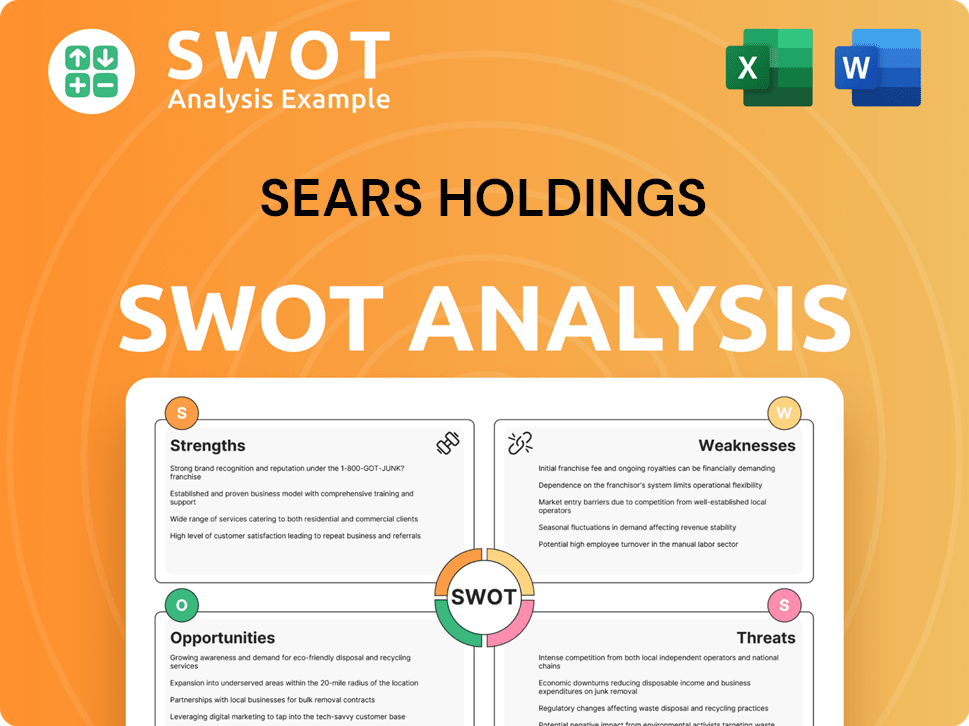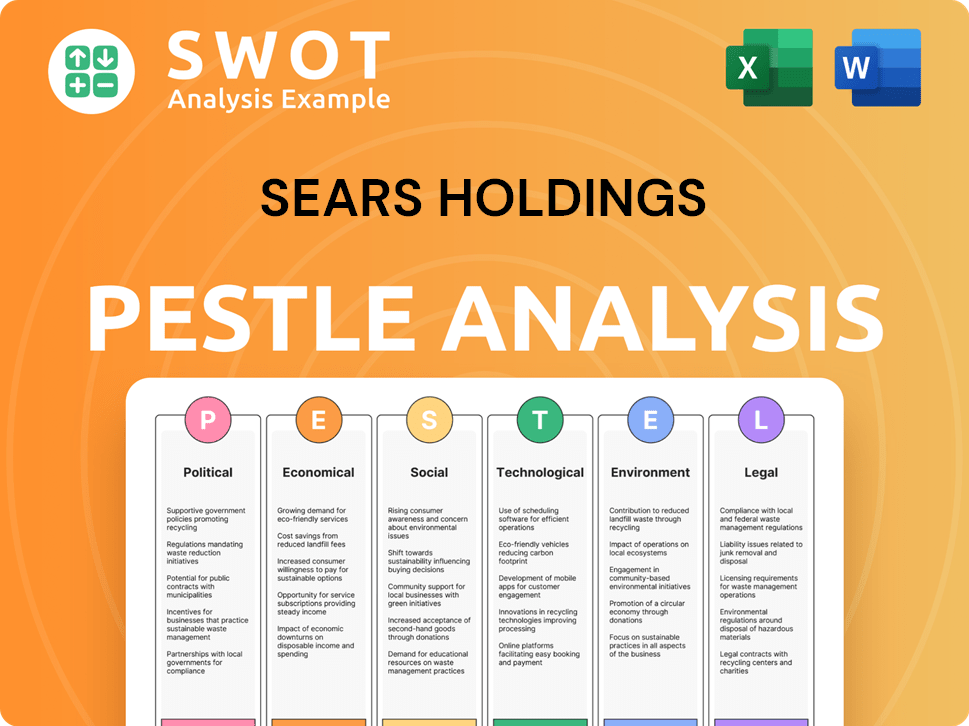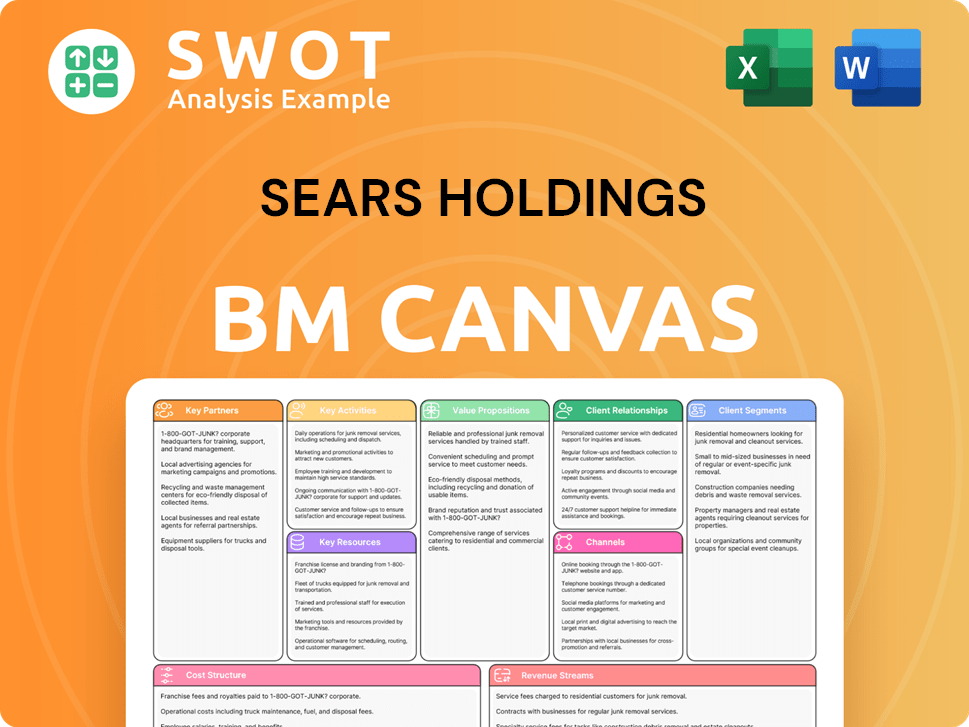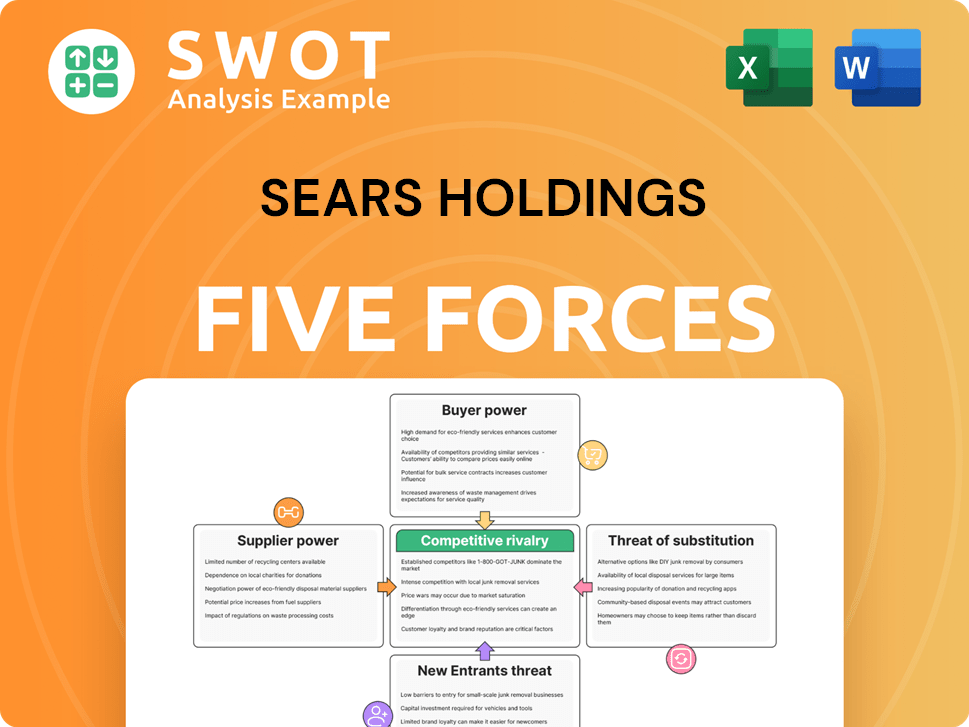Sears Holdings Bundle
Can Sears' Retail Demise Teach Us About Sales and Marketing?
Explore the dramatic fall of Sears, a retail giant that once defined American consumerism, and uncover the critical role of sales and marketing in corporate survival. From catalog pioneer to bankruptcy, Sears' journey offers invaluable lessons on adapting to market shifts and the impact of strategic decisions. Learn how Sears Holdings Company navigated (and ultimately failed to navigate) the evolving retail landscape.

This analysis delves into the Sears Holdings SWOT Analysis, examining the company's attempts to reach customers, its marketing tactics, and brand positioning. We'll dissect Sears' sales strategy and marketing plan, including its responses to changing consumer behavior and the impact on its sales performance. Understanding "How did Sears fail in marketing" provides crucial insights for modern businesses navigating the complexities of retail strategy and digital transformation, covering topics like Sears' digital marketing strategy analysis and Sears' online sales strategy.
How Does Sears Holdings Reach Its Customers?
The sales channels of the former Sears Holdings Company, a subject of interest for understanding its Sears sales strategy and Sears marketing strategy, primarily revolved around a combination of physical retail locations and online platforms. Historically, the company's vast network of brick-and-mortar stores, including both Sears and Kmart, served as the primary points of sale, offering a wide array of products from apparel to appliances. E-commerce platforms like sears.com and kmart.com were introduced to complement the physical stores, allowing customers to shop online and utilize services like in-store pickup.
The evolution of these channels saw an attempt at omnichannel integration, aiming to merge the online and offline shopping experiences to enhance the retail strategy. However, despite these efforts, the physical retail footprint steadily declined due to declining sales and mounting debt, leading to numerous store closures, particularly after 2010. The company's sales performance in the years leading up to its bankruptcy reflected a significant downturn in brick-and-mortar sales, with online sales struggling to fully offset the losses.
The company also engaged in strategic partnerships, such as those with brands like Kenmore and Craftsman, which were historically exclusive to Sears and contributed significantly to its sales and market share in specific product categories. However, even these iconic brands were eventually sold off as part of the liquidation process. For an in-depth look at the target demographic, consider reviewing the Target Market of Sears Holdings.
The foundation of the sales strategy was built on a vast network of physical stores. These stores provided direct customer interaction and immediate product availability. However, this channel faced challenges due to changing consumer preferences and economic downturns.
E-commerce platforms, such as sears.com and kmart.com, were introduced to cater to online shoppers. These platforms offered convenience and a broader product selection. Despite efforts, online sales growth was not enough to compensate for the decline in physical store sales.
The company aimed to integrate online and offline shopping experiences. This included features like in-store pickup and online returns. The success of this strategy was limited due to the declining physical store presence.
Partnerships with brands like Kenmore and Craftsman were crucial to the company's sales. These exclusive brands provided a unique selling proposition. The eventual sale of these brands marked a significant shift in the company's sales strategy.
The primary challenge was the decline in physical store sales, which was not adequately offset by online sales. The company struggled to adapt to changing consumer behaviors and market trends. The liquidation of the company reflects the failure of its sales and marketing strategies.
- Store closures accelerated after 2010, indicating a failing marketing plan.
- Online sales growth was insufficient to compensate for the loss of physical store revenue.
- Strategic partnerships, though valuable, were not enough to reverse the decline.
- The company's response to changing consumer behavior was too slow.
Sears Holdings SWOT Analysis
- Complete SWOT Breakdown
- Fully Customizable
- Editable in Excel & Word
- Professional Formatting
- Investor-Ready Format

What Marketing Tactics Does Sears Holdings Use?
The Brief History of Sears Holdings reveals the company's evolution in sales and marketing strategies. Initially, the company relied heavily on traditional methods, but it attempted to integrate digital approaches as the retail landscape shifted. These efforts, however, were often insufficient to compete effectively.
The Sears marketing strategy and Sears sales strategy involved a mix of traditional and digital tactics. The effectiveness of these strategies diminished over time. Although the company aimed to engage customers through various channels, its inability to adapt quickly to changing consumer behaviors and market trends contributed to its declining sales performance.
The Sears Holdings Company utilized a range of marketing tactics to build brand awareness and drive sales. The company's approach evolved from a heavy reliance on traditional media to an attempt at digital integration. However, the company struggled to innovate or execute experimental strategies effectively in a rapidly changing retail landscape, ultimately failing to reverse its declining fortunes.
Sears heavily invested in traditional advertising methods. This included TV commercials, radio spots, and print advertisements in newspapers and catalogs. These channels were crucial for brand building and promoting sales events.
The company also attempted to engage in digital marketing. Efforts included content marketing, search engine optimization (SEO), and paid advertising. Email marketing was used for customer retention and promotions.
Sears maintained a presence on social media platforms. This was done to interact with customers and promote products. However, the impact of social media marketing was limited compared to its competitors.
The company's data-driven marketing and customer segmentation were often criticized. The ability to translate customer data into highly targeted and effective campaigns was limited. This was a disadvantage compared to competitors.
Sears did have loyalty programs. However, the effectiveness of these programs was limited by the company's overall marketing strategy. The loyalty programs did not significantly boost sales.
There is no current information on specific technology platforms or analytics tools used by Sears in 2024-2025. This is due to its cessation of retail operations. The company's technological infrastructure was outdated.
The Sears marketing strategy faced several challenges. These included the inability to adapt to the fast-changing retail landscape. The company struggled to innovate and execute experimental strategies effectively. The focus on traditional media was a significant disadvantage.
- Ineffective Digital Integration: The company's digital marketing efforts lagged behind competitors. The lack of a strong online presence hurt sales.
- Poor Customer Data Utilization: Limited ability to leverage customer data for targeted campaigns. This resulted in less effective marketing efforts.
- Outdated Technology: The company's reliance on outdated technology hampered its ability to compete. The lack of modern tools limited its marketing capabilities.
- Slow Response to Consumer Behavior: The company was slow to respond to changing consumer preferences. This resulted in a decline in sales.
Sears Holdings PESTLE Analysis
- Covers All 6 PESTLE Categories
- No Research Needed – Save Hours of Work
- Built by Experts, Trusted by Consultants
- Instant Download, Ready to Use
- 100% Editable, Fully Customizable

How Is Sears Holdings Positioned in the Market?
The brand positioning of the former company, historically, centered on being a dependable, all-inclusive retailer. The core message focused on value, reliability, and convenience. It aimed to be a one-stop shop for various products, from appliances to apparel. The Competitors Landscape of Sears Holdings reveals the challenges faced in maintaining this position.
The visual identity often conveyed familiarity and tradition, with an approachable and dependable tone of voice. The promised customer experience was one of broad product selection and accessibility. However, as the retail landscape evolved, this positioning became increasingly difficult to maintain.
The company primarily targeted a broad, middle-class audience, emphasizing value and practicality. It aimed to capture a significant market share in categories like appliances with its Kenmore brand and tools with Craftsman. However, it struggled to differentiate itself in other segments against specialized retailers and discounters. The company's sales performance declined significantly in the years leading up to its bankruptcy, indicating a failure to adapt to changing consumer preferences and competitive pressures.
The brand was built on trust and being a comprehensive retailer. The core message revolved around value, reliability, and convenience, aiming to be a one-stop shop.
The primary target was the middle-class, emphasizing value and practicality. The company aimed to appeal to a broad customer base seeking a wide range of products.
The visual identity often evoked familiarity and tradition. The tone of voice aimed to be approachable and dependable, creating a sense of trust with customers.
The promised experience was one of accessibility and a broad selection of products. The goal was to provide convenience and a wide array of choices for shoppers.
Sears Holdings Business Model Canvas
- Complete 9-Block Business Model Canvas
- Effortlessly Communicate Your Business Strategy
- Investor-Ready BMC Format
- 100% Editable and Customizable
- Clear and Structured Layout

What Are Sears Holdings’s Most Notable Campaigns?
The sales and marketing strategy of Sears Holdings Company, a once-dominant force in the retail sector, evolved significantly throughout its history. The company employed various strategies, from traditional catalog marketing to attempts at modernizing its approach in the face of changing consumer behavior and increasing competition. Understanding these strategies provides insights into the challenges faced by traditional retailers in the digital age.
Historically, Sears heavily relied on its 'Sears Wish Book,' an annual Christmas catalog that served as a cornerstone of its marketing efforts. This catalog, a cultural icon, was a primary driver of holiday sales for decades. Sears also launched campaigns to promote specific product categories and services, aiming to boost sales and customer loyalty. These campaigns, however, struggled to compete with the changing retail landscape.
In its later years, as the company grappled with financial difficulties, Sears focused on campaigns to revitalize its image and boost sales. These included promotions for appliances and home services, such as the 'Sears Blue Crew.' Despite these efforts, the company faced significant challenges, and these campaigns often failed to generate the necessary sales lift to offset the broader decline in its business.
The 'Sears Wish Book' was a cornerstone of Sears' sales strategy for many years. It was a highly effective marketing tool, particularly during the holiday season. The catalog showcased a wide array of products, driving significant sales and brand recognition.
Sears frequently ran campaigns to highlight appliance sales, leveraging its reputation in this product category. These campaigns aimed to attract customers and maintain market share. Despite these efforts, the company faced difficulties in the highly competitive appliance market.
The 'Sears Blue Crew' campaign focused on home services, aiming to capitalize on Sears' historical strength in repairs and installations. The objective was to build customer loyalty and generate service revenue. This campaign was a part of the company's effort to adapt to changing consumer needs.
Sears attempted to incorporate digital marketing into its strategy, but these efforts were limited. The company's ability to compete in the digital space was constrained. Analysis of Sears' digital marketing strategy reveals that it lagged behind its competitors.
Sears' sales strategy involved a mix of traditional and modern approaches. The 'Wish Book' was a key component of its sales efforts. The company also used in-store promotions and targeted advertising to drive sales.
The marketing plan included the 'Wish Book', appliance sales, and home services. The company's marketing budget was allocated across various channels. Sears' brand positioning strategy evolved over time.
Sears' retail strategy focused on a combination of physical stores and online sales. The company faced challenges in adapting to changing consumer behavior. A key aspect of its retail strategy was how it responded to consumer preferences.
One of the key questions is 'How did Sears fail in marketing?' Sears struggled to compete with online retailers. The company's response to changing consumer behavior was often too late.
Sears focused on customer acquisition through various campaigns. These strategies included loyalty programs and promotions. The company's ability to acquire and retain customers was crucial.
Sears' brand positioning strategy was critical to its success. The company's use of social media marketing was limited. For a deeper understanding, explore the Growth Strategy of Sears Holdings.
Sears Holdings Porter's Five Forces Analysis
- Covers All 5 Competitive Forces in Detail
- Structured for Consultants, Students, and Founders
- 100% Editable in Microsoft Word & Excel
- Instant Digital Download – Use Immediately
- Compatible with Mac & PC – Fully Unlocked

Related Blogs
- What are Mission Vision & Core Values of Sears Holdings Company?
- What is Competitive Landscape of Sears Holdings Company?
- What is Growth Strategy and Future Prospects of Sears Holdings Company?
- How Does Sears Holdings Company Work?
- What is Brief History of Sears Holdings Company?
- Who Owns Sears Holdings Company?
- What is Customer Demographics and Target Market of Sears Holdings Company?
Disclaimer
All information, articles, and product details provided on this website are for general informational and educational purposes only. We do not claim any ownership over, nor do we intend to infringe upon, any trademarks, copyrights, logos, brand names, or other intellectual property mentioned or depicted on this site. Such intellectual property remains the property of its respective owners, and any references here are made solely for identification or informational purposes, without implying any affiliation, endorsement, or partnership.
We make no representations or warranties, express or implied, regarding the accuracy, completeness, or suitability of any content or products presented. Nothing on this website should be construed as legal, tax, investment, financial, medical, or other professional advice. In addition, no part of this site—including articles or product references—constitutes a solicitation, recommendation, endorsement, advertisement, or offer to buy or sell any securities, franchises, or other financial instruments, particularly in jurisdictions where such activity would be unlawful.
All content is of a general nature and may not address the specific circumstances of any individual or entity. It is not a substitute for professional advice or services. Any actions you take based on the information provided here are strictly at your own risk. You accept full responsibility for any decisions or outcomes arising from your use of this website and agree to release us from any liability in connection with your use of, or reliance upon, the content or products found herein.